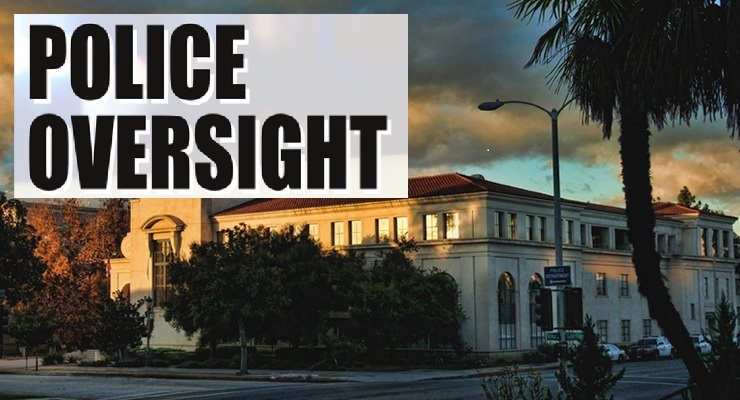
The City’s Police Oversight Commission will hear and discuss an informational report on arrest disparities between Pasadena, South Pasadena, and Glendale today.
Although the cover date on the report is listed as Feb. 2024, the data used is from 2011 to 2021 — prior to Police Chief Eugene Harris’ arrival in Pasadena.
Pasadena Now first reported on the data in February after City News Service published a news story on the report.
The data showed large disparities in arrests by race, according to an analysis issued by the Los Angeles County Commission on Human Relations.
An information item was scheduled to come before the Commission earlier this year.
According to the report, Black and Latino arrest rates in Pasadena, South Pasadena, and Glendale were much higher than those for whites and Asians.
The report in Thursday’s meeting is over 100 pages long. The researchers are using historical data up to 2021 to examine trends and patterns in policing practices across these suburban Los Angeles County cities.
The study was published by the County Commission on Human Relations in partnership with Dr. Seva Rodnyansky and Dr. Jorgen Harris, both of Occidental College.
The CNS story did not reveal how many of the arrests occurred as a result of calls to the police for service by a third party, or how many were initiated by police during traffic stops, or as a result of an officer making contact with a citizen without a call for service.
One day after the City News Service story, the City released a statement to Pasadena Now.
“The Pasadena Police Department has an ongoing commitment to responsiveness regardless of race, and we will continue to respond to any and all calls for service,” said Pasadena Police Eugene Harris. “In 2022 and 2023, the percentages are commensurate with crime reports received by the police department and should be taken in context with the increased transitory population in the city of Pasadena, as that number increases significantly during the daytime and special events unique to the city. In the spirit of transparency and continued improvement, we report the data regularly to the City Council and the Community Policing Oversight Commission. The last report was on February 5, 2024, and is posted on the city website.”
After the story, representative of local community group My TRIBE Rise met with Harris, Deputy Chief Art Chute, researchers for a dialogue on the project, and an Los Angeles Commissioner.
Harris asked for time to respond to the information, but so far My TRIBE Rise has not sought a follow up meeting.
According to the story, the report found that all three police departments had an arrest rate of between 40 and 42 per 10,000 residents in 2011 and 2012 — matching the arrest rate in the city of Los Angeles.
However, between 2011 and 2019, arrest rates diverged considerably.
The report showed arrests per 10,000 citizens were unchanged in Glendale and increased in Pasadena to 48 per 10,000 citizens. As a result, Glendale and Pasadena have conducted nearly twice as many arrests per resident in recent years than has the city of Los Angeles.
While arrests per resident fell in Glendale and Pasadena in 2020 and 2021 with the COVID-19 pandemic, they remained well above the arrest rates in Los Angeles and South Pasadena, the report says.
In Los Angeles and South Pasadena, arrests per 10,000 fell by close to 50%, reaching 22 per 10,000 citizens in Los Angeles and 24 per 10,000 citizens in South Pasadena, according to the commission.
According to the report’s breakdown, Latinos account for 42% of arrestees in Glendale, 45% in Pasadena, 55% in South Pasadena, and 47% in Los Angeles.
Black arrestees constitute the second-largest racial category in Los Angeles and Pasadena, and the third-largest racial category in Glendale and South Pasadena. Black arrestees accounted for 8% of arrests in Glendale, 12% of arrests in South Pasadena, 27% of
arrests in Pasadena, and 29% of arrests in Los Angeles, the commission reported.
At the same time, white arrestees account for 20% to 30% of arrestees in each city.
In Glendale, which has a large Armenian American population, 27% of arrestees were white and do not have an Armenian surname, while an additional 18% of arrestees had an Armenian surname — the large majority of whom were identified by the police department as white, according to the report.
White arrestees, including white-identifying Armenians, made up 27% of arrests in South Pasadena, 21% of arrests in Pasadena, and 19% of arrests in Los Angeles. Asian arrestees made up a small share of arrests in all four cities, from 5% of arrests in South Pasadena to less than 1% of arrests in Los Angeles.
In a look at arrestee demographics, the study found that:
Black and Latino arrestees are over-represented relative to the population in all four cities, including Los Angeles;
The rate of over-representation for Black and Latino arrestees has barely changed over the past 10 years;
The female share of arrestees is 21% for Los Angeles, 21% for Glendale, 22% for Pasadena, and on par with the national average in South Pasadena (26%). The share of Asian arrestees who are women is somewhat higher than for other races, ranging from 27% in Glendale to 41% in Los Angeles; and
In Pasadena, over half of arrests were of residents, with a higher proportion for those who were booked rather than cited. In
Glendale, slightly fewer than half of booked arrestees were non-residents. Black and Hispanic arrestees are over-represented among city residents in both cities.
In terms of geography, findings showed police activity centered on the largest commercial and office areas of Pasadena (Old Pasadena), Glendale (Americana/Galleria in the downtown area), and South Pasadena (Fair Oaks and Mission streets), suggesting that suburban police focus their attention on the highest traffic areas and on protection of property and the economy.



















